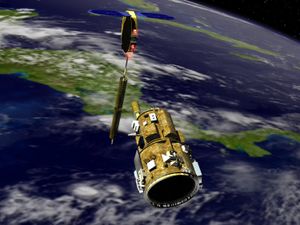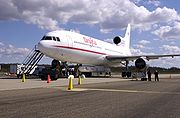
DART (spacecraft)
Encyclopedia

NASA
The National Aeronautics and Space Administration is the agency of the United States government that is responsible for the nation's civilian space program and for aeronautics and aerospace research...
sponsored project. The goal was to develop and demonstrate an automated navigation and rendezvous capability in a NASA spacecraft. Currently, only the Russian Space Agency, JAXA and ESA have autonomous space craft navigation. Orbital Sciences Corporation
Orbital Sciences Corporation
Orbital Sciences Corporation is an American company which specializes in the manufacturing and launch of satellites. Its Launch Systems Group is heavily involved with missile defense launch systems...
(OSC) was the prime contractor for construction, launch and operation of the DART vehicle with a project cost of $95 million dollars. The contract was awarded in June 2001 and the launch originally scheduled for October 25, 2004, but this was postponed for launch loads analysis and instead performed on April 15, 2005.
Mission
DART was launched on a Pegasus rocketPegasus rocket
The Pegasus rocket is a winged space launch vehicle capable of carrying small, unmanned payloads into low Earth orbit. It is air-launched, as part of an expendable launch system developed by Orbital Sciences Corporation . Three main stages burning solid propellant provide the thrust...
into a polar
Polar orbit
A polar orbit is an orbit in which a satellite passes above or nearly above both poles of the body being orbited on each revolution. It therefore has an inclination of 90 degrees to the equator...
circular
Circular orbit
A circular orbit is the orbit at a fixed distance around any point by an object rotating around a fixed axis.Below we consider a circular orbit in astrodynamics or celestial mechanics under standard assumptions...
parking orbit
Parking orbit
A parking orbit is a temporary orbit used during the launch of a satellite or other space probe. A launch vehicle boosts into the parking orbit, then coasts for a while, then fires again to enter the final desired trajectory...
of 760 by 770 km (472.2 by 478.5 mi) and has International Designator
International Designator
The International Designator, also known as COSPAR designation, and in the United States as NSSDC ID, is an international naming convention for satellites...
2005-014-A. The craft is 2 by and weighs 360 kg (793.7 lb). The maneuvering system comprises 16 nitrogen
Nitrogen
Nitrogen is a chemical element that has the symbol N, atomic number of 7 and atomic mass 14.00674 u. Elemental nitrogen is a colorless, odorless, tasteless, and mostly inert diatomic gas at standard conditions, constituting 78.08% by volume of Earth's atmosphere...
-fueled thrusters with three hydrazine
Hydrazine
Hydrazine is an inorganic compound with the formula N2H4. It is a colourless flammable liquid with an ammonia-like odor. Hydrazine is highly toxic and dangerously unstable unless handled in solution. Approximately 260,000 tons are manufactured annually...
-fueled thrusters and a reaction control system
Reaction control system
A reaction control system is a subsystem of a spacecraft whose purpose is attitude control and steering by the use of thrusters. An RCS system is capable of providing small amounts of thrust in any desired direction or combination of directions. An RCS is also capable of providing torque to allow...
including six nitrogen-fueled thrusters from the Pegasus fourth stage, which forms an integral part of the craft. The target is an OSC MUBLCOM
MUBLCOM
The Multiple Paths, Beyond-Line-of-Sight Communications satellite, built for the Pentagon's Defense Advanced Research Projects Agency, was launched in May 1999 by a Pegasus rocket...
(Multiple-Path Beyond-Line-of-Sight Communications) prototype communications relay satellite weighing around 49 kg (108 lb) launched from Vandenberg Air Force Base
Vandenberg Air Force Base
Vandenberg Air Force Base is a United States Air Force Base, located approximately northwest of Lompoc, California. It is under the jurisdiction of the 30th Space Wing, Air Force Space Command ....
on 18 May 1999 with International Designator 1999-026-B.

DART had no capability for interactive piloting from the ground or for uploading new programming after launch, thus all on-orbit operations were directed by DART itself based upon pre-programmed criteria.
The initial mission was to occur over about 24 hours but its premature failure occurred after only about 11 hours.
Automatic orbital transfer maneuvers
The craft autonomously navigated via a series of orbit transfer maneuversOrbital maneuver
In spaceflight, an orbital maneuver is the use of propulsion systems to change the orbit of a spacecraft.For spacecraft far from Earth—for example those in orbits around the Sun—an orbital maneuver is called a deep-space maneuver .-delta-v:...
to reach the target satellite. No navigational information was relayed to the vehicle after launch; it navigated autonomously and with GPS.
Proximity operations with AVGS
Once the spacecraft had navigated to the target satellite, it was to have performed a series of proximity maneuvers. The maneuvers would have demonstrated the capabilities of the AVGS (Advanced Video Guidance Sensor). It was planned to demonstrate station keeping, docking axis approach, circumnavigation, and a collision avoidance maneuver. DART would have then departed the vicinity and retired to a final orbit. The entire sequence was to have been accomplished under autonomous control.Additional demonstrations
- Safe operations
- Validate ground test results of the AVGS and proximity-operations algorithms
- Provide hardware capabilities for future missions by validating the AVGS in the space environment

Mishap investigation board
NASA convened a mishap investigation board to determine the reason for the DART spacecraft anomaly. First reports pointed to the spacecraft running out of fuel before concluding its mission.On April 14, 2006 NASA announced that they would not release the investigation's report, citing that the report includes details protected by the International Traffic in Arms Regulations
International Traffic in Arms Regulations
International Traffic in Arms Regulations is a set of United States government regulations that control the export and import of defense-related articles and services on the United States Munitions List...
.
On May 15, 2006 NASA released a public summary of the DART mishap investigation board report (NASA press release). NASA revealed that a critical navigation failure occurring when the DART and MUBLCOM spacecraft were about 200 meters apart precluded the full activation of the AVGS, and allowed DART to approach MUBLCOM without accurate ranging information. A later failure of the collision avoidance system, which was relying upon inaccurate position and velocity information, allowed DART to ultimately collide with MUBLCOM at a relative speed of approximately 1.5 meters per second. Both spacecraft survived the collision without apparent damage. Throughout the autonomous proximity operations, DART used its limited propellant faster than anticipated, which caused "a premature end to the mission" 3 minutes 49 seconds after the collision. DART initiated its retirement programming, removed itself from the vicinity of MUBLCOM, and prepared for deorbit. After the collision, MUBLCOM "regained its operational status after an automatic system reset".
The DART Mishap Investigation Board determined that only 11 of the 27 defined mission objectives were partially or fully met, all of which related to the launch, early orbit, rendezvous, departure, and retirement phases. None of the 14 objectives related to the proximity operations phase were met.
Current status
As of May 2006, DART remains in its polar retirement orbit of about 390 by 470 km (242.3 by 292 mi), and MUBLCOM remains in a polar orbit of 740 by 750 km (459.8 by 466 mi).See also
- Attitude control
- Orbital ExpressOrbital Expressthumb|Orbital Express: ASTRO and NEXTSatOrbital Express was a space mission managed by the United States Defense Advanced Research Projects Agency and a team led by engineers at NASA's Marshall Space Flight Center...
- SpacecraftSpacecraftA spacecraft or spaceship is a craft or machine designed for spaceflight. Spacecraft are used for a variety of purposes, including communications, earth observation, meteorology, navigation, planetary exploration and transportation of humans and cargo....
External links
- DART at Marshall Space Flight Center
- NASA Press release about the DART mishap 16 April 2005
- Mishap overview and description of the cause 15 May 2006
- DART Mishap Investigation Board Final Report January 4, 2007

